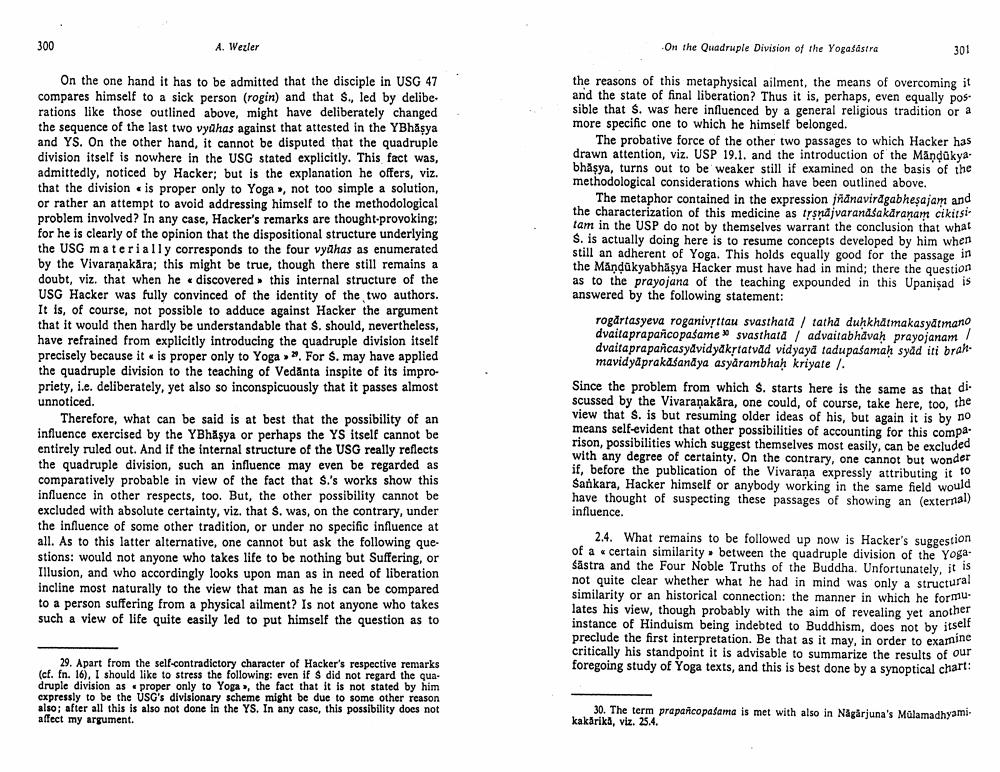Book Title: On Quadruple Division Of Yogasastra Author(s): A Wezler Publisher: A Wezler View full book textPage 7
________________ A. Wexler On the Quadruple Division of the Yogasastra 301 On the one hand it has to be admitted that the disciple in USG 47 compares himself to a sick person (rogin) and that S., led by delibe. rations like those outlined above, might have deliberately changed the sequence of the last two vydhas against that attested in the YBhasya and YS. On the other hand, it cannot be disputed that the quadruple division itself is nowhere in the USG stated explicitly. This fact was, admittedly, noticed by Hacker; but is the explanation he offers, viz. that the division is proper only to Yoga », not too simple a solution, or rather an attempt to avoid addressing himself to the methodological problem involved? In any case, Hacker's remarks are thought-provoking: for he is clearly of the opinion that the dispositional structure underlying the USG materially corresponds to the four vydhas as enumerated by the Vivaranakära; this might be true, though there still remains a doubt, viz. that when he discovered this internal structure of the USG Hacker was fully convinced of the identity of the two authors. It is, of course, not possible to adduce against Hacker the argument that it would then hardly be understandable that S. should, nevertheless, have refrained from explicitly introducing the quadruple division itself precisely because it is proper only to Yoga For S. may have applied the quadruple division to the teaching of Vedanta inspite of its impropriety, i.e. deliberately, yet also so inconspicuously that it passes almost unnoticed. Therefore, what can be said is at best that the possibility of an influence exercised by the YBhäşya or perhaps the YS itself cannot be entirely ruled out. And If the internal structure of the USG really reflects the quadruple division, such an influence may even be regarded as comparatively probable in view of the fact that S.'s works show this influence in other respects, too. But, the other possibility cannot be excluded with absolute certainty, viz. that S. was, on the contrary, under the influence of some other tradition, or under no specific influence at all. As to this latter alternative, one cannot but ask the following questions: would not anyone who takes life to be nothing but Suffering, or Illusion, and who accordingly looks upon man as in need of liberation incline most naturally to the view that man as he is can be compared to a person suffering from a physical ailment? Is not anyone who takes such a view of life quite easily led to put himself the question as to the reasons of this metaphysical ailment, the means of overcoming it and the state of final liberation? Thus it is, perhaps, even equally possible that S. was here influenced by a general religious tradition or a more specific one to which he himself belonged. The probative force of the other two passages to which Hacker has drawn attention, viz. USP 19.1. and the introduction of the Mandakvabhāşya, turns out to be weaker still if examined on the basis of the methodological considerations which have been outlined above. The metaphor contained in the expression jñanavirágabhesajam and the characterization of this medicine as trsndjvaranasakaranam cikitsi tam in the USP do not by themselves warrant the conclusion that what S. is actually doing here is to resume concepts developed by him when still an adherent of Yoga. This holds equally good for the passage in the Mändokyabhāşya Hacker must have had in mind; there the question as to the prayojana of the teaching expounded in this Upanişad 15 answered by the following statement: rogartasyeva roganivettau svasthata / tatha duhkhatmakasydtmano, dvaita prapancopašame svasthata / advaitabhavah prayojanam dvaita prapancasydvidydkytatvad vidyaya tadupasamah sydd iti brak. mavidyaprakasandya asydrambhah kriyale. Since the problem from which S. starts here is the same as that di scussed by the Vivaranakära, one could, of course, take here, too, the view that s. is but resuming older ideas of his, but again it is by no means self-evident that other possibilities of accounting for this compa: rison, possibilities which suggest themselves most easily, can be excluded with any degree of certainty. On the contrary, one cannot but wonder if, before the publication of the Vivarana expressly attributing it to Sankara, Hacker himself or anybody working in the same field would have thought of suspecting these passages of showing an (external) influence. 2.4. What remains to be followed up now is Hacker's suggestion of a certain similarity between the quadruple division of the Yoga Sāstra and the Four Noble Truths of the Buddha. Unfortunately, it is not quite clear whether what he had in mind was only a structural similarity or an historical connection: the manner in which he formu. lates his view, though probably with the aim of revealing yet another instance of Hinduism being indebted to Buddhism, does not by itself preclude the first interpretation. Be that as it may, in order to examine critically his standpoint it is advisable to summarize the results of our foregoing study of Yoga texts, and this is best done by a synoptical chart: 29. Apart from the self-contradictory character of Hacker's respective remarks Icf. En. 16), I should like to stress the following: even if S did not regard the qua druple division as proper only to Yoga >, the fact that it is not stated by him expressly to be the USG's divisionary scheme might be due to some other reason also; after all this is also not done in the YS. In any case, this possibility does not affect my argument. 30. The term praparicopasama is met with also in Nagarjuna's Mülamadhyami. kakärikā, viz. 25.4.Page Navigation
1 ... 5 6 7 8 9 10 11 12 13 14 15 16 17 18 19 20 21 22 23 24 25
